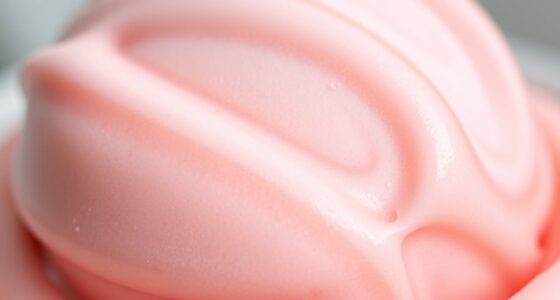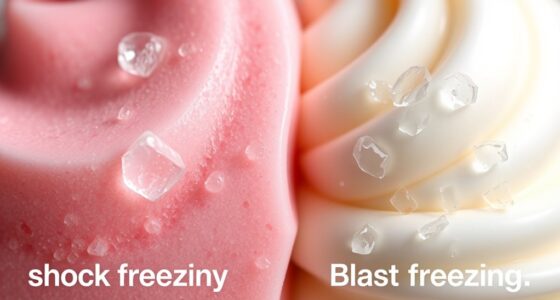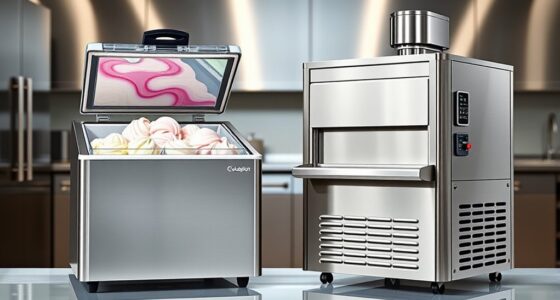Using liquid nitrogen for gelato allows you to instantly freeze the mixture at extremely low temperatures, around -321°F. This rapid process prevents large ice crystal formation, resulting in a smooth, velvety texture that’s impossible with traditional freezing. As you pour and stir, the gelato becomes creamy and luxurious in seconds. The technique also lock in flavors and freshness. If you want to discover how this innovative method enhances your gelato, keep exploring further.
Key Takeaways
- Liquid nitrogen freezes gelato instantly, forming tiny ice crystals for a smooth, velvety texture.
- Continuous stirring during freezing ensures even consistency and prevents large ice crystal formation.
- Proper safety precautions, like gloves and goggles, are essential when handling liquid nitrogen.
- The rapid freezing preserves flavors and ingredients’ freshness, enhancing gelato quality.
- This method offers a faster, more controlled alternative to traditional slow freezing.

Have you ever wondered how some gelato achieves its irresistibly smooth and creamy texture? The secret often lies in using liquid nitrogen, a powerful tool for rapid freezing that transforms the ice cream base into a luxuriously velvety treat.
Unlike traditional methods that slowly freeze gelato and allow large ice crystals to form, liquid nitrogen freezes the mixture almost instantly at a temperature of -321°F (-196°C). This rapid freezing process prevents the development of sizable ice crystals, which can make gelato grainy or icy. Instead, tiny ice crystals develop, resulting in a smoother, creamier texture that melts beautifully in your mouth.
Liquid nitrogen freezes gelato instantly, preventing large ice crystals and creating a smooth, melt-in-your-mouth texture.
When preparing gelato with liquid nitrogen, you begin by pouring the cold, bubbling liquid into a mixing bowl containing the ice cream base. As you do this, you’ll notice the mixture instantly begins to freeze while you stir continuously. This constant movement ensures the freezing occurs evenly, creating a uniform consistency.
The extreme cold causes the fats and water particles in the gelato to freeze rapidly, locking in flavor and preventing the formation of large, undesirable ice crystals. The end result is a gelato with a velvety, luscious mouthfeel that’s difficult to achieve with slower freezing methods.
Handling liquid nitrogen requires careful safety precautions. Since it’s extremely cold, you should always wear protective gloves and goggles to prevent frostbite or eye injuries. Working in a well-ventilated area is also vital because the nitrogen gas can displace oxygen, posing a suffocation hazard in enclosed spaces. By respecting these safety measures, you can enjoy the benefits of this innovative freezing technique without risk.
The key to the process is maintaining the right temperature and stirring constantly. As the gelato base cools quickly, it transforms into a smooth, creamy consistency almost immediately. The rapid freezing locks in the ingredients’ freshness and enhances the flavor, giving you a superior gelato experience.
This method leverages the extremely low temperature of liquid nitrogen to control ice crystal size precisely, which is crucial for achieving the desired velvety texture. The velvety texture achieved through liquid nitrogen is a proof to how controlling temperature and ice crystal size can elevate the quality of frozen desserts. This method isn’t just about speed; it’s about precision and craftsmanship, resulting in gelato that’s irresistibly smooth and luxurious from the very first spoonful.
Frequently Asked Questions
Is It Safe to Use Liquid Nitrogen to Make Ice Cream?
You wonder if using liquid nitrogen to make ice cream is safe. When you follow proper safety procedures—wear gloves, goggles, and handle it in a well-ventilated space—it’s generally safe.
Always avoid direct skin contact, use the right tools, and keep the area ventilated. As long as you handle it responsibly, liquid nitrogen won’t affect the ice cream’s taste and offers a quick, fun freezing process.
How to Make Ice Cream With Liquid Nitrogen?
To make ice cream with liquid nitrogen, start by preparing your custard or ice cream base. Pour it into a heat-resistant bowl.
Then slowly add liquid nitrogen while stirring constantly with a wooden or heat-proof spoon. Keep stirring until the mixture becomes thick and scoopable, usually within a minute.
Remember to wear protective gloves and goggles for safety, and serve immediately for the best texture.
Can Liquid Nitrogen Turn Into Ice?
Did you know liquid nitrogen stays a liquid at -321°F (-196°C)? You might wonder if it can turn into ice.
In normal conditions, it doesn’t freeze into solid ice on its own. Instead, it quickly vaporizes when warmed.
To turn liquid nitrogen into ice, you’d need a supercooled environment or cryogenic chamber. Without that, it remains a liquid or vapor, not ice.
Why Is Liquid Nitrogen Ice Cream so Creamy?
You notice that liquid nitrogen ice cream feels incredibly creamy because the rapid freezing creates tiny ice crystals, preventing a grainy texture.
This quick process keeps more of the original fat intact, adding to its richness. It also minimizes cellular damage, preserving the smooth, velvety consistency you love.
The extreme cold guarantees a silky, luxurious mouthfeel, making each bite feel indulgently smooth and special.
Conclusion
Using liquid nitrogen for gelato is like wielding a magic wand, transforming simple ingredients into a creamy masterpiece in seconds. It allows you to conjure up frozen delights with a burst of science and creativity. With this technique, you’re not just making gelato—you’re crafting a frozen work of art that’s as smooth as silk and as fresh as a mountain breeze. So, embrace the chill and let your imagination freeze in time!









